Peter R. Wurman
Sony AI
A Champion-level Vision-based Reinforcement Learning Agent for Competitive Racing in Gran Turismo 7
Apr 12, 2025Abstract:Deep reinforcement learning has achieved superhuman racing performance in high-fidelity simulators like Gran Turismo 7 (GT7). It typically utilizes global features that require instrumentation external to a car, such as precise localization of agents and opponents, limiting real-world applicability. To address this limitation, we introduce a vision-based autonomous racing agent that relies solely on ego-centric camera views and onboard sensor data, eliminating the need for precise localization during inference. This agent employs an asymmetric actor-critic framework: the actor uses a recurrent neural network with the sensor data local to the car to retain track layouts and opponent positions, while the critic accesses the global features during training. Evaluated in GT7, our agent consistently outperforms GT7's built-drivers. To our knowledge, this work presents the first vision-based autonomous racing agent to demonstrate champion-level performance in competitive racing scenarios.
SimBa: Simplicity Bias for Scaling Up Parameters in Deep Reinforcement Learning
Oct 13, 2024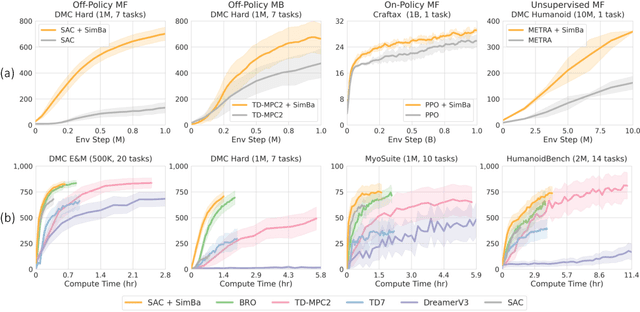

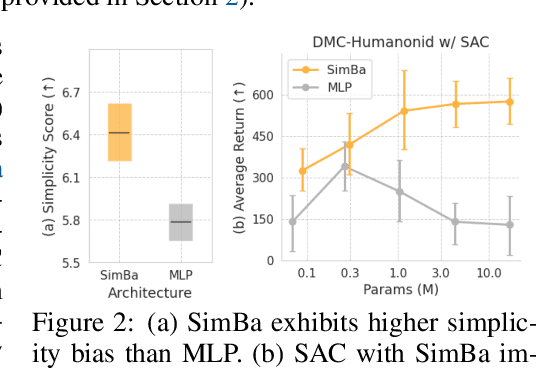
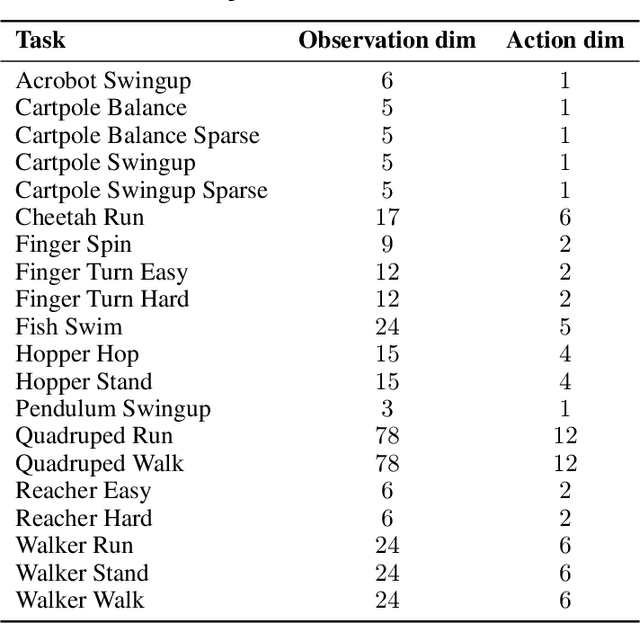
Abstract:Recent advances in CV and NLP have been largely driven by scaling up the number of network parameters, despite traditional theories suggesting that larger networks are prone to overfitting. These large networks avoid overfitting by integrating components that induce a simplicity bias, guiding models toward simple and generalizable solutions. However, in deep RL, designing and scaling up networks have been less explored. Motivated by this opportunity, we present SimBa, an architecture designed to scale up parameters in deep RL by injecting a simplicity bias. SimBa consists of three components: (i) an observation normalization layer that standardizes inputs with running statistics, (ii) a residual feedforward block to provide a linear pathway from the input to output, and (iii) a layer normalization to control feature magnitudes. By scaling up parameters with SimBa, the sample efficiency of various deep RL algorithms-including off-policy, on-policy, and unsupervised methods-is consistently improved. Moreover, solely by integrating SimBa architecture into SAC, it matches or surpasses state-of-the-art deep RL methods with high computational efficiency across DMC, MyoSuite, and HumanoidBench. These results demonstrate SimBa's broad applicability and effectiveness across diverse RL algorithms and environments.
A Super-human Vision-based Reinforcement Learning Agent for Autonomous Racing in Gran Turismo
Jun 18, 2024



Abstract:Racing autonomous cars faster than the best human drivers has been a longstanding grand challenge for the fields of Artificial Intelligence and robotics. Recently, an end-to-end deep reinforcement learning agent met this challenge in a high-fidelity racing simulator, Gran Turismo. However, this agent relied on global features that require instrumentation external to the car. This paper introduces, to the best of our knowledge, the first super-human car racing agent whose sensor input is purely local to the car, namely pixels from an ego-centric camera view and quantities that can be sensed from on-board the car, such as the car's velocity. By leveraging global features only at training time, the learned agent is able to outperform the best human drivers in time trial (one car on the track at a time) races using only local input features. The resulting agent is evaluated in Gran Turismo 7 on multiple tracks and cars. Detailed ablation experiments demonstrate the agent's strong reliance on visual inputs, making it the first vision-based super-human car racing agent.
Composing Efficient, Robust Tests for Policy Selection
Jun 12, 2023Abstract:Modern reinforcement learning systems produce many high-quality policies throughout the learning process. However, to choose which policy to actually deploy in the real world, they must be tested under an intractable number of environmental conditions. We introduce RPOSST, an algorithm to select a small set of test cases from a larger pool based on a relatively small number of sample evaluations. RPOSST treats the test case selection problem as a two-player game and optimizes a solution with provable $k$-of-$N$ robustness, bounding the error relative to a test that used all the test cases in the pool. Empirical results demonstrate that RPOSST finds a small set of test cases that identify high quality policies in a toy one-shot game, poker datasets, and a high-fidelity racing simulator.
Value Function Decomposition for Iterative Design of Reinforcement Learning Agents
Jun 24, 2022
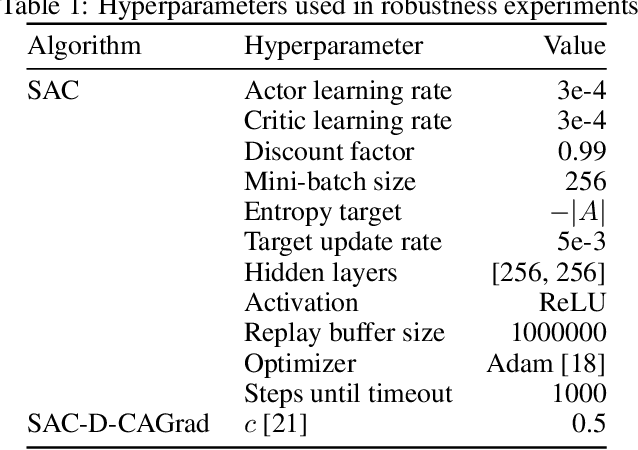
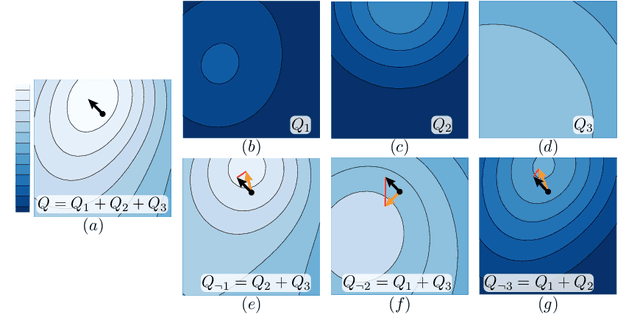

Abstract:Designing reinforcement learning (RL) agents is typically a difficult process that requires numerous design iterations. Learning can fail for a multitude of reasons, and standard RL methods provide too few tools to provide insight into the exact cause. In this paper, we show how to integrate value decomposition into a broad class of actor-critic algorithms and use it to assist in the iterative agent-design process. Value decomposition separates a reward function into distinct components and learns value estimates for each. These value estimates provide insight into an agent's learning and decision-making process and enable new training methods to mitigate common problems. As a demonstration, we introduce SAC-D, a variant of soft actor-critic (SAC) adapted for value decomposition. SAC-D maintains similar performance to SAC, while learning a larger set of value predictions. We also introduce decomposition-based tools that exploit this information, including a new reward influence metric, which measures each reward component's effect on agent decision-making. Using these tools, we provide several demonstrations of decomposition's use in identifying and addressing problems in the design of both environments and agents. Value decomposition is broadly applicable and easy to incorporate into existing algorithms and workflows, making it a powerful tool in an RL practitioner's toolbox.
Analysis and Observations from the First Amazon Picking Challenge
Sep 22, 2017



Abstract:This paper presents a overview of the inaugural Amazon Picking Challenge along with a summary of a survey conducted among the 26 participating teams. The challenge goal was to design an autonomous robot to pick items from a warehouse shelf. This task is currently performed by human workers, and there is hope that robots can someday help increase efficiency and throughput while lowering cost. We report on a 28-question survey posed to the teams to learn about each team's background, mechanism design, perception apparatus, planning and control approach. We identify trends in this data, correlate it with each team's success in the competition, and discuss observations and lessons learned based on survey results and the authors' personal experiences during the challenge.
Optimal Factory Scheduling using Stochastic Dominance A*
Feb 13, 2013



Abstract:We examine a standard factory scheduling problem with stochastic processing and setup times, minimizing the expectation of the weighted number of tardy jobs. Because the costs of operators in the schedule are stochastic and sequence dependent, standard dynamic programming algorithms such as A* may fail to find the optimal schedule. The SDA* (Stochastic Dominance A*) algorithm remedies this difficulty by relaxing the pruning condition. We present an improved state-space search formulation for these problems and discuss the conditions under which stochastic scheduling problems can be solved optimally using SDA*. In empirical testing on randomly generated problems, we found that in 70%, the expected cost of the optimal stochastic solution is lower than that of the solution derived using a deterministic approximation, with comparable search effort.
 Add to Chrome
Add to Chrome Add to Firefox
Add to Firefox Add to Edge
Add to Edge